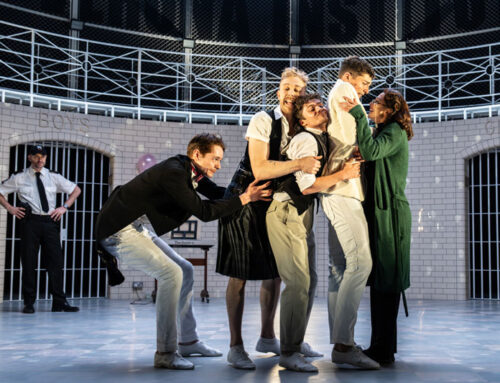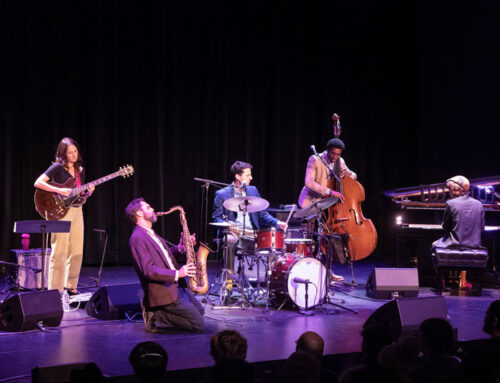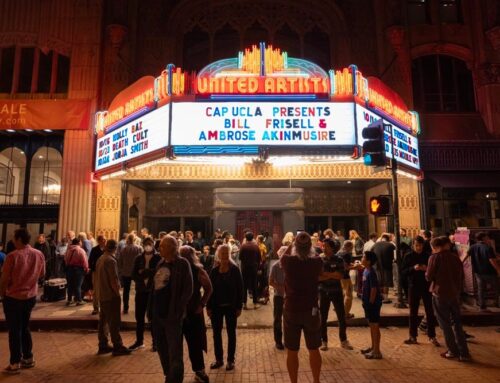T.S. Eliot’s sequence of poems, Four Quartets, was brought to life through the creative collaboration that joined together the engaging choreography of Pam Tanowit, a dreamy score composed by Kaija Saariaho as performed live by The Knights, backed by large scale images by minimalist painter artist Brice Marden, and guided by the dramatic narration of actor Kathleen Chalfant.
Dancers perform in ‘Four Quartets; All photos by Reed Hutchinson; courtesy of CAP UCLA;
Eliot’s philosophically meditative poetic work, which itself uses dance as a metaphor, explores the concepts of time and space. In the performance, the four poems are read aloud and accompanied by the atmospheric sounds of strings and harp. The dancers, wearing billowy pale green and off-white jumpsuits, illuminate the words in solos, duets and ensemble segments moving around and through the planes and recesses of the entire stage surrounded by gauzy backdrops and curtains.
Tanowitz’s choreography blends classical ballet and modern dance movement that has the dancers prance, jump, interact and serenely pose while highlighting impressive footwork, precise, elegant and subtle lower and upper body movements, and expressive arm and hand gestures.
Four Quartets consists of four separate lengthy poems that were blended together in the 75-minute performance through transitions of the artistic stage settings. Given the richness of the poetic language, watching the performance brought to mind Einstein’s descriptive analogy of the theory of relativity – when feeling totally engaged in the flow of the words, music and movement, time moved quickly; when it felt more dense, time slowed down.
![]() Individually each poem and performance sequence:
Individually each poem and performance sequence:
“Burnt Norton” presents the concept that only the present moment really matters because the past cannot be changed and the future is unknown and it is important to focus on “the still point” to experience “a grace of sense” and “love”. Music: “Maa (Earth): VI. Fall”; Image: Uphill 4 (detail), 2014, 4 joined panels 48 x 144 inches overall, oil on linen
“East Coker” focuses on life, death, and the continuity between the two with humans portrayed as disorderly and with science and reason leading mankind to warfare only to be saved through Christ. Music: “…de la Terre”; Image: Thira, 1979-1980, 18 joined panels 96 x 180 inches overall, oil and wax on canvas.
“The Dry Salvages” posits that we are all connected and the patterns found through the past allow us to see that there is meaning and we have the ability to experience eternity through moments of revelation. Music: “Cloud Trio: I, II, and IV,” “Maa (Earth): VI. Fall,” and “Sept Papillons III and IV”; Image: Untitled (Hydra), 2018, 83 x 270 inches (each panel: 83 x 135 inches), oil on linen
In “Little Gidding” the theme is time and humanity’s place within it and the poet’s attempt to help the world through language to work on the soul and on society. Music: “Vent Nocturne: I and II” and “Cloud Trio: III” Image: Painting Study II, 1980, 20×24 inches, ink over screen print on paper.
![]() To quote Eliot, “And the end of all our exploring/ Will be to arrive where we started/ And know the place for the first time.”
To quote Eliot, “And the end of all our exploring/ Will be to arrive where we started/ And know the place for the first time.”
Four Quartets: Text by T. S. Eliot; Choreography by Pam Tanowitz; Music by Kaija Saariaho; Images by Brice Marden; Music Performed by The Knights (Colin Jacobsen, Violin; Nicholas Cords, Viola; Hannah Collins, Cello; Jane Yoon, Harp); Narrated by Kathleen Chalfant; Scenic and Lighting Design by Clifton Taylor; Costume Design by Reid Bartelme and Harriet Jung; Sound Design by Jean-Baptiste Barriére; Performed by Kara Chan, Jason Collins, Dylan Crossman, Christine Flores, Zachary Gonder, Lindsey Jones, Victor Lozano, Maile Okamura, and Melissa Toogood. Reid Bartelme, understudy.
UCLA’s Center for the Art of Performance https://cap.ucla.edu

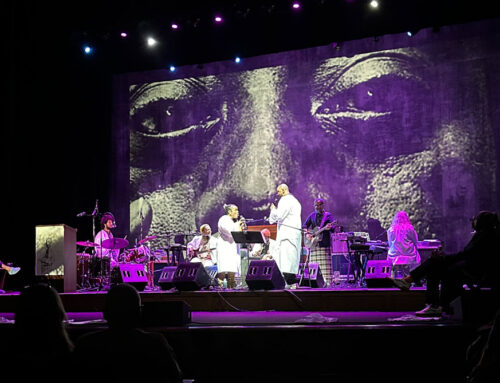
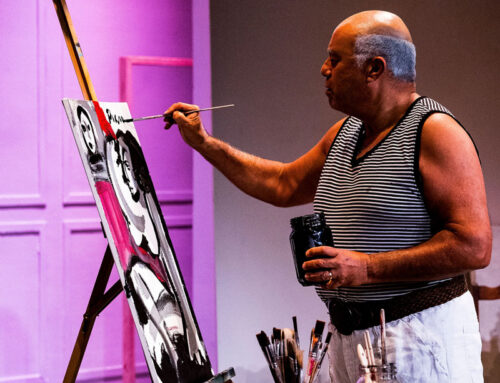
![Review: The Rite of Spring & common ground[s] at the Music Center](https://www.laartparty.com/wp-content/uploads/2024/02/review-feb2024-music-ctr-common-ground-credit-maarten-vanden-abeele-web-800-500x383.jpg)
